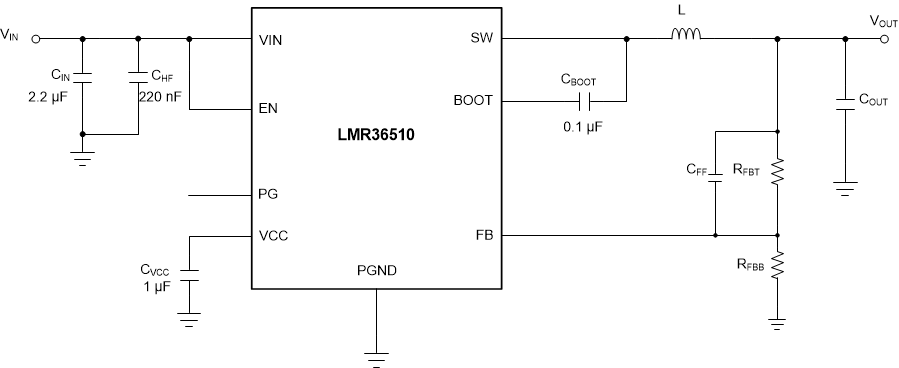SNVSBD7A October 2019 – February 2020 LMR36510
PRODUCTION DATA.
- 1 Features
- 2 Applications
- 3 Description
- 4 Revision History
- 5 Pin Configuration and Functions
- 6 Specifications
- 7 Detailed Description
- 8 Application and Implementation
- 9 Power Supply Recommendations
- 10Layout
- 11Device and Documentation Support
- 12Mechanical, Packaging, and Orderable Information
Package Options
Mechanical Data (Package|Pins)
- DDA|8
Thermal pad, mechanical data (Package|Pins)
- DDA|8
Orderable Information
8.2 Typical Application
Figure 13 shows a typical application circuit for the LMR36510. This device is designed to function over a wide range of external components and system parameters. However, the internal compensation is optimized for a certain range of external inductance and output capacitance. As a quick-start guide, provides typical component values for a range of the most common output voltages.
 Figure 13. Example Applications Circuit
Figure 13. Example Applications Circuit Table 1. Typical External Component Values
| ƒSW (kHz) | VOUT (V) | L (µH) | NOMINAL COUT (RATED CAPACITANCE) (1) | MINIMUM COUT (RATED CAPACITANCE) (2) | RFBT (Ω) | RFBB (Ω) | CIN | CFF |
|---|---|---|---|---|---|---|---|---|
| 400 | 3.3 | 22 | 3 × 22 µF | 2 x 22 µF | 100 k | 43.2 k | 1 × 2.2 µF + 220 nF | None |
| 400 | 5 | 22 | 2 × 22 µF | 1 x 22 µF | 100 k | 24.9 k | 1 × 2.2 µF + 220 nF | None |
| 400 | 12 | 47 | 3 × 10 µF | 2 × 10 µF | 100 k | 9.09 k | 1 × 2.2 µF + 220 nF | None |
(1) Optimized for superior load transient performance from 0 to 100% rated load
(2) Optimized for size constrained end applications